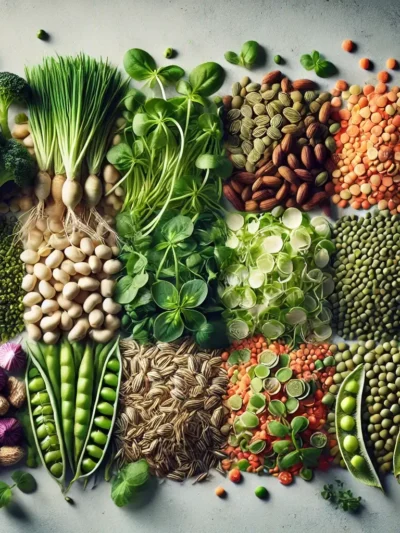THE Brazilian diet It is a vibrant mosaic of flavors, colors and culinary traditions that span a country of continental dimensions.
More than just a set of typical dishes, it represents the cultural identity and rich biodiversity of Brazil.
In this complete guide and updated, we will reveal the secrets of the Brazilian diet, exploring its fundamental pillars, the challenges it faces and the innovative strategies to incorporate it into your daily life in a healthy, tasty and sustainable way.
A Sensory Journey Through the Five Regions of Brazil
Embark on a gastronomic journey through the five regions of Brazil and discover a universe of ingredients, aromas and flavors that sharpen the senses:
- North: Let yourself be enchanted by açaí, rich in antioxidants, jambu, with its unique flavor and medicinal properties, charimã, source of proteins and fibers, by tucupi, a yellow broth with an intense flavor, and by maniçoba, a typical dish made from cassava leaves. Northern cuisine,strongly influenced by indigenous culture, is an invitation to explore the flavors of the Amazon rainforest.
- North East: Taste the Stew, a fish or seafood stew with coconut milk and palm oil, the vatapa, a creamy custard made with bread, shrimp and coconut milk, the couscous, a versatile side dish made with cornmeal, the Shrimp bean ball, a fried black-eyed pea dumpling stuffed with vatapá and caruru, and the tapioca, a thin pancake made with cassava starch that can be filled with various ingredients. Northeastern cuisine,marked by Afro-Brazilian, indigenous and European cultural mixing, is a festival of colors, aromas and spices.
- Midwest: Try the pequi, a fruit with a strong flavor and unique texture, gueroba, a native fruit with medicinal properties, cornmeal, a dish made from grated fresh corn cooked in milk, the roasted hump, a tender and tasty meat roasted on the grill, and the Goiano pie, a savory pie filled with chicken, catupiry and cream cheese. The cuisine of the Midwest,influenced by the tropeiro culture and local ingredients from the cerrado, is an invitation to enjoy the authentic flavors of the interior of Brazil.
- Southeast: Indulge in the feijoada, a black bean stew with dried meat, sausage, paio and seasonings, the cheese bread, a delicacy made with tapioca flour, cheese and milk, the brigadier, a sweet made from condensed milk, chocolate powder and butter, stew from capixaba, a fish stew with tomato, onion, pepper and palm oil, and the bean tutu, a mashed bean stew with seasonings and milk. Southeastern cuisine,rich in influences from different cultures and marked by the miscegenation of the Brazilian people, is a banquet of flavors and aromas that represent the soul of the country.
- South: Enjoy the barbecue, a gaucho tradition that brings together grilled meats, such as picanha, ribs and sausage, the mate, a bitter tea made with yerba mate, the pinion, a seed with a unique flavor when cooked or roasted, polenta, a side dish made with cornmeal, and the truck driver, a dish made with dried meat, rice, beans and charque. Southern cuisine,strongly influenced by Italian, German and Polish immigration, is an invitation to discover the striking flavors and hospitality of the southern people.
The Pillars of the Brazilian Diet: A Symphony of Nutrients and Flavors

The Brazilian diet stands out for being rich in natural and minimally processed foods, such as fruits, vegetables, legumes, whole grains, oilseeds and quality sources of animal protein.
This nutritious base offers several health benefits, which translate into a symphony of well-being:
- Strengthening the immune system: The high amount of vitamins, minerals and antioxidants present in foods in the Brazilian diet contributes to the proper functioning of the immune system, protecting the body against diseases and infections.
- Prevention of chronic diseases: Regular consumption of fruits, vegetables and legumes, rich in fiber, vitamins and minerals, helps prevent chronic diseases such as diabetes, heart disease and some types of cancer.
- Weight control: The Brazilian diet, rich in fiber and low in calories, helps maintain a healthy body weight, preventing obesity and its associated risks.
- Improved digestive health: The fibers present in whole grains, fruits and vegetables help regulate the intestines, preventing diseases and other digestive problems.
- Increased disposition: Consuming foods rich in B vitamins, such as those found in meat, legumes and whole grains, contributes to increased energy and disposition for daily life.
- Improved mood: The Brazilian diet, rich in nutrients such as tryptophan and selenium, helps in the production of serotonin, a neurotransmitter responsible for feelings of well-being and mood.
- Skin and hair health: The vitamins and minerals present in foods in the Brazilian diet contribute to the health of the skin and hair, leaving them stronger, shinier and hydrated.
- Strengthening bones and teeth: The calcium found in dairy products, dark green vegetables and legumes is essential for healthy bones and teeth, preventing diseases such as osteoporosis.
- Reducing the risk of neurodegenerative diseases: The consumption of red fruits, oilseeds and fish, rich in antioxidants, help prevent neurodegenerative diseases such as Alzheimer's and Parkinson's.
- Longevity: A diet rich in nutrients and low in processed foods contributes to increased life expectancy and quality of life in old age.
- The Brazilian diet, in addition to offering several health benefits, also provides a unique and tasty gastronomic experience. The variety of fresh and typical ingredients from each region of Brazil allows the creation of creative and appetizing dishes, which please the most demanding palates.
- It is important to emphasize that the Brazilian diet must be personalized according to each person's individual needs. Consult a nutritionist for a complete and balanced eating plan that meets your specific needs and contributes to your overall well-being.
The Challenges and Strategies to Recover the Essence of the Brazilian Diet
Despite the richness and benefits of the Brazilian diet, some challenges prevent it from being fully enjoyed by the population.
- The industrialization of food: The advancement of the ultra-processed food industry offers practical and cheap options, but they are nutritionally poor.
- Lack of knowledge and nutritional education: Many people are unaware of the advantages of regional foods and creative ways to prepare them.
To overcome these challenges, it is essential to adopt innovative strategies:
- Value local producers: Look for local markets and fairs to buy fresh, seasonal food grown by local producers.
- Innovate in the kitchen: Experiment with traditional recipes and explore modern ways to include regional ingredients in everyday meals.
- Search for information: Use Brazilian cooking websites, blogs and chef channels to learn about typical foods and ways to prepare them.
Reclaiming Flavor: Tips for Including Regional Foods in Your Routine

Incorporating the Brazilian diet into your daily life is easier than you think. Check out some practical tips:
- Include at least one regional food in each meal: Start the day with a smoothie made with local fruits, add oilseeds from the Cerrado to your snack, use regional flours to prepare breads and cakes, and try less common meats, such as goat meat from the Northeast, in main dishes.
- Have a vegetable garden at home: Grow aromatic herbs and spices typical of your region to add a special touch to your meals.
- Bet on seasonality: Take advantage of seasonal fruits, vegetables and legumes to ensure freshness, flavor and affordable prices.
A Matter of Culture and Sustainability: The Value of the Brazilian Diet
The Brazilian diet goes beyond gastronomy. It carries with it the cultural wealth, the history and the identity from each region of the country. By valuing local foods, we are preserving traditions passed down from generation to generation.
Furthermore, the Brazilian diet is, in essence, sustainable. Prioritizing locally grown food reduces the carbon footprint associated with long-distance transportation.
By supporting family farming and conscious consumption, we contribute to the preservation of the environment and the development of local communities.
Conclusion: Embark on a Journey of Flavors and Well-Being
The Brazilian diet is a treasure trove to be explored. By choosing a diet rich in regional ingredients, you not only take care of your health, but also connect with the culture and traditions of your country.
Start incorporating the flavors of Brazil into your table today! Discover a world of culinary possibilities, feel good and contribute to a more sustainable future.
Don't forget the healthy recipes that our website provides to help you go further on your journey.









